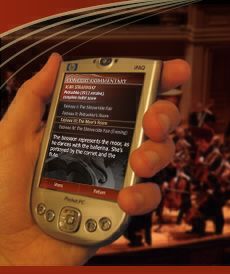Special Reports
Tweeting Program Notes, a Few Early Experiments
 One area that would seem a natural for smartphone use during concerts is that of real-time program notes. Patrons could read about the music as it happened. Most arts organizations post their program notes on the web, and one could easily read them on a smartphone during a concert, although that lacks the real-time aspect. Some organizations use Twitter to notify fans of their availability; the Los Angeles Chamber Orchestra actually puts its notes on Twitter as an image, to avoid the 140-character limit.
One area that would seem a natural for smartphone use during concerts is that of real-time program notes. Patrons could read about the music as it happened. Most arts organizations post their program notes on the web, and one could easily read them on a smartphone during a concert, although that lacks the real-time aspect. Some organizations use Twitter to notify fans of their availability; the Los Angeles Chamber Orchestra actually puts its notes on Twitter as an image, to avoid the 140-character limit.
The Lancaster (PA) Symphony takes that idea one step farther. Last year the orchestra launched Symphony in a Snap!—a new concert program targeted at busy young professionals. The one-hour early evening performances feature a pre-concert catered networking reception, a smartphone-friendly concert, open-seating, and a post-concert after-party at a local restaurant.
A statement says: “Attendees choose their own seats and may use their smartphones and their Twitter pages to follow the Symphony’s customized program notes Tweeted during the performance. The Tweets include informative comments on the selections being performed. Audience members may also participate by re-Tweeting or commenting on a Tweet.”
The experiment was deemed a sufficient success to run again this season, on a concert with pianist Santiago Rodriguez booked for five performances in the Fulton Opera House during May.
Musical pop-up book at Wolf Trap
It is outdoor events that seem the most likely setting for the successful use of program notes via mobile media. In 2009, the National Symphony Orchestra
experimented with real-time Twittered notes during a performance of Beethoven’s Symphony No. 6 at Virginia’s Wolf Trap Park. “With this first ever in-time symphonic Twitter you can have the conductor as your personal guide through Beethoven’s most colorful and atmospheric work,” wrote conductor Emil de Cou in the advance promotion. “I have designed the Tweets to go perfectly with ideas I have about the piece as I conduct it but also some interesting commentary to go along with the sights and sounds of Beethoven’s day in the countryside: an adult musical pop-up book written for first-timers and concert veterans alike.”
Before the concert began, messages provided facts about Beethoven’s life and work. During the concert, Tweets were sent at specific points in the score, becoming streaming program notes that marked musical signposts through the work.
Concert host the Filene Center did not allow electronic devices in the main house, so the Twitter initiative was for the benefit of those seated outside on the lawn: NSO and Wolf Trap followers on Twitter were encouraged with discount lawn tickets through a promotional code included in a series of Tweets before the concert. According to an NSO spokeswoman, however, the experiment remained just that; no further real-time program note avenues have been pursued since.
 RIP the Concert Companion
RIP the Concert Companion
A few years ago, Roland Valliere invented the Concert Companion, which provided program notes in real time. A handheld device available for use during the concert, it was trialed by the New York Philharmonic, Philadelphia Orchestra, Pittsburgh Symphony, Aspen Music Festival, Kansas City Symphony, and Oakland East Bay Symphony, and featured at the 2005 annual conference of the Association of British Orchestras. When first introduced, it seemed a natural. But it somehow never took off. it seemed a natural. But it somehow never took off. These days, smartphones have made such single-purpose devices (remember the iPod? the camera?) obsolete.

Keith Clarke is a freelance music journalist and consulting editor of Classical Music magazine, which he edited for 21 years. He has been the London correspondent for Musical America and MusicalAmerica.com since 1999.





 FEATURED JOBS
FEATURED JOBS

 RENT A PHOTO
RENT A PHOTO


